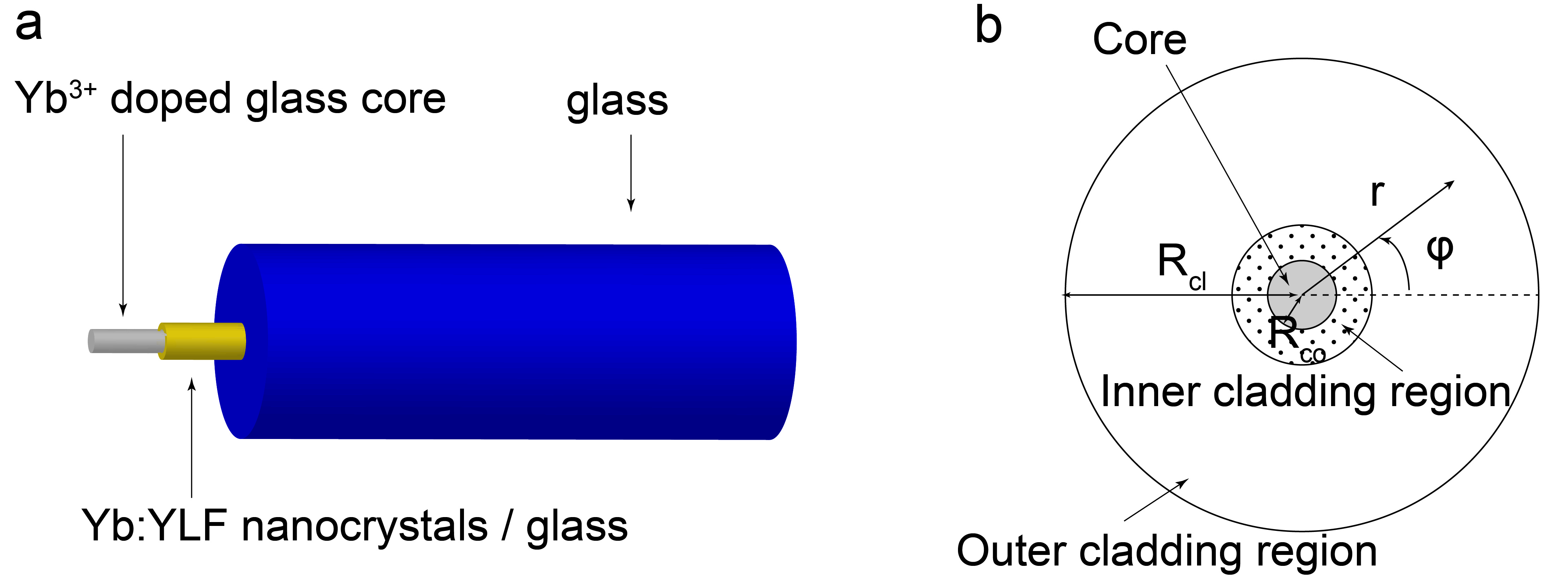2022
79. Reduced photothermal heating in diamonds enriched with H3 point defects
Anupum Pant, Chaman Gupta, Katharina Senkalla, Greg Felsted, Xiaojing Xia, Tobias Spohn, Scott T. Dunham, Fedor Jelezko, and Peter J. Pauzauskie “Dynamics of Optically-Trapped High-Aspect-Ratio β-NaYF Hexagonal Prisms — Towards kHz-MHz Gravitational Wave Searches”
https://doi.org/10.1063/5.0090661
78. Dynamics of Optically-Trapped High-Aspect-Ratio β-NaYF Hexagonal Prisms — Towards kHz-MHz Gravitational Wave Searches
George Winstone, Zhiyuan Wang, Shelby Klomp, Greg Felsted, Andrew Laeuger, Daniel Grass, Nancy Aggarwal, Jacob Sprague, Peter J. Pauzauskie, Shane L. Larson, Vicky Kalogera, Andrew A. Geraci “Dynamics of Optically-Trapped High-Aspect-Ratio β-NaYF Hexagonal Prisms — Towards kHz-MHz Gravitational Wave Searches”
PRL link: https://link.aps.org/doi/10.1103/PhysRevLett.129.053604
arXiv link: https://arxiv.org/abs/2204.10843
77. Chemically tunable aspect ratio control and laser refrigeration of hexagonal sodium yttrium fluoride upconverting materials
Felsted, R.; Pant, Anupum; Bard, Alexander; Xia, Xiaojing; Luntz-Martin, Danika; Dadras, Siamak; zhang, Shuai; Vamivakas, Anthony; Pauzauskie, Peter “Chemically tunable aspect ratio control and laser refrigeration of hexagonal sodium yttrium fluoride upconverting materials” Crystal Growth & Design 2022 (Accepted)
76. Safe and Scalable Polyethylene Glycol-Assisted Hydrothermal Synthesis and Laser Cooling of 10%Yb3+:LiLuF4 Crystals
2021
75. Hydrothermal Synthesis of Yb3+:LuLiF4 Microcrystals and Laser Refrigeration of Yb3+:LuLiF4 / Silicon-Nitride Composite Nanostructures
Elena A. Dobretsova, Xiaojing Xia, Anupum Pant, Matthew B. Lim, Michael С. De Siena, Kirill N. Boldyrev, Anastasia D. Molchanova, Nadezhda N. Novikova, Sergey A. Klimin, Marina N. Popova, Yueyang Chen, Arka Majumdar, Daniel R. Gamelin, Peter J. Pauzauskie “Hydrothermal Synthesis of Yb3+:LuLiF4 Microcrystals and Laser Refrigeration of Yb3+:LuLiF4 / Silicon-Nitride Composite Nanostructures” Laser & Photonics Reviews 2021
74. Laser refrigeration of optically levitated sodium yttrium fluoride nanocrystals
73. The impact of 2H9/2 ➔4I13/2 emission from Er3+ ions on ratiometric optical temperature sensing with Yb3+/Er3+ co-doped upconversion materials
Abstract: Yb3+/Er3+ co-doped upconversion materials are widely used for luminescence intensity ratio (LIR) thermometry, where the relative intensity ratio of the green luminescence transitions (2H11/2 → 4I15/2 and 4S3/2 → 4I15/2) of Er3+ dopant ions changes with temperature. In this work we report on the impact of an additional transition from the 2H9/2 level to the intermediate 4I13/2 level, which overlaps with the green luminescence normally used for LIR thermometry. The 2H9/2 → 4I13/2 emission overlaps extensively with the 4S3/2 → 4I15/2 emission and is more sensitive to pump power. The wavelength intervals used to integrate both 2H11/2 → 4I15/2 and 4S3/2 → 4I15/2 luminescence need be selected carefully in order to achieve accurate temperature readouts.
72. Solid-state laser refrigeration of nanodiamond quantum sensors
71. Laser-Driven Growth of Semiconductor Nanowires from Colloidal Nanocrystals
70. Solid-state laser refrigeration at GPa pressures
69. Hydrothermal Synthesis and Solid-State Laser Refrigeration of Ytterbium-Doped Potassium Lutetium Fluoride (KLF) Microcrystals
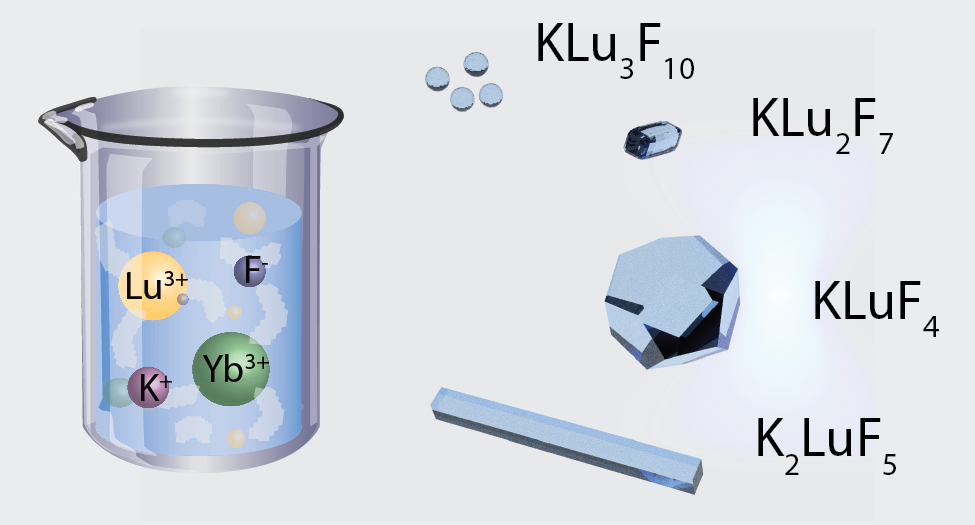
2020
68. Spectroscopic Signatures of the B and H4 Polyatomic Nitrogen Aggregates in Nanodiamond
67. Additive Manufacturing of a Flexible Carbon Monoxide Sensor Based on a SnO2-Graphene Nanoink
66. Quantum point-defects for solid-state laser-refrigeration

https://onlinelibrary.wiley.com/doi/full/10.1002/adma.201905406
65. A Mechanistic Understanding of Non-Classical Crystal Growth in Hydrothermally Synthesized Sodium Yttrium Fluoride Nanowires
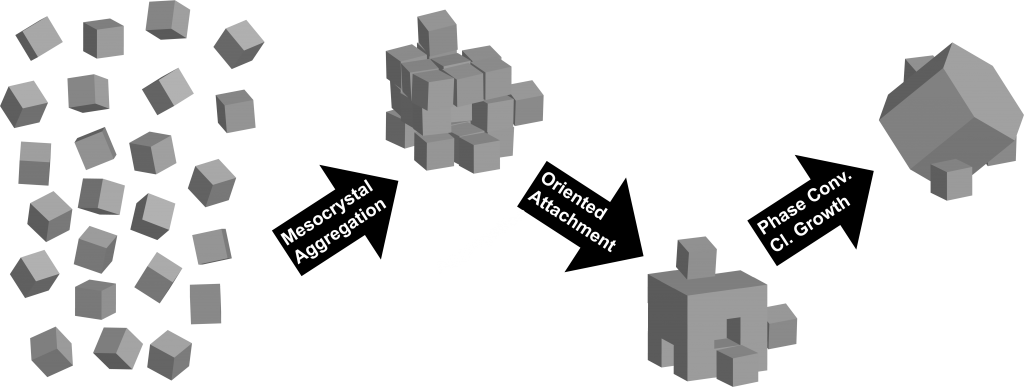
https://pubs.acs.org/doi/10.1021/acs.chemmater.9b04076
DOI: 10.1021/acs.chemmater.9b04076
64. Solid-state laser refrigeration of a semiconductor optomechanical resonator
Anupum Pant, Xiaojing Xia, E. James Davis, Peter J. Pauzauskie. “Solid-state laser refrigeration of a semiconductor optomechanical resonator” Nat. Commun. (2020).
nanoscale optoelectronic and optomechanical devices including nanolasers, quantum optomechanical resonators and integrated photonic circuits. Although radiation-pressure damping has been reported to cool an individual vibrational mode of an optomechanical resonator to its quantum ground state to date the internal material temperature within an optomechanical resonator has not been reported to cool via laser excitation. Here we demonstrate the direct laser refrigeration of a semiconductor optomechanical resonator >20K below room temperature based on the emission of upconverted, anti-Stokes photoluminescence of trivalent ytterbium ions doped within a yttrium-lithium-fluoride (YLF) host crystal. Optically-refrigerating the lattice of a dielectric resonator has the potential to impact several
fields including scanning probe microscopy, the sensing of weak forces the measurement
of atomic masses, and the development of radiation-balanced solid-state lasers. In addition, optically refrigerated resonators may be used in the future as a promising starting point to perform motional cooling for exploration of quantum effects at mesoscopic length scales, temperature control within integrated photonic devices, and solid-state laser refrigeration of quantum materials.
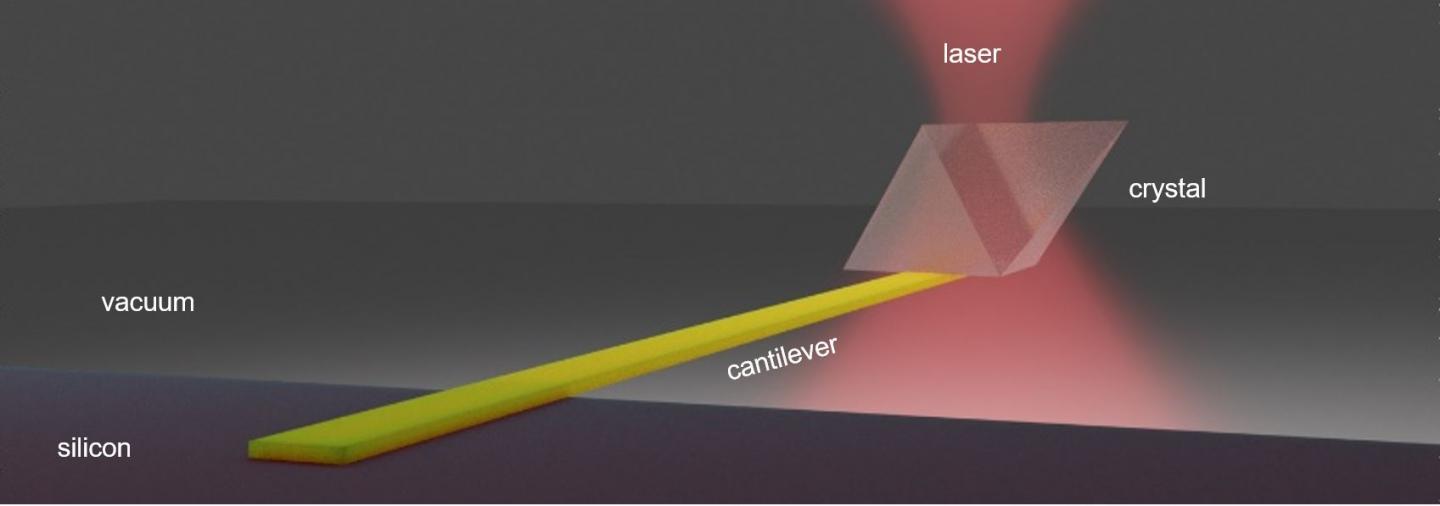
63. Crystalline Loading of Lipophilic Coenzyme Q10 Pharmaceuticals within Conjugated Carbon Aerogel Derivatives
Matthew B. Lim, Abbie S. Ganas, Jennifer L. Hanson, Xuezhe Zhou, Brittney Hellner, Sandeep Manandhar, Rachel E. Gariepy, François Baneyx, D. Scott Wilbur, Peter J. Pauzauskie. “Crystalline Loading of Lipophilic Coenzyme Q10 Pharmaceuticals within Conjugated Carbon Aerogel Derivatives” Carbon (2020).
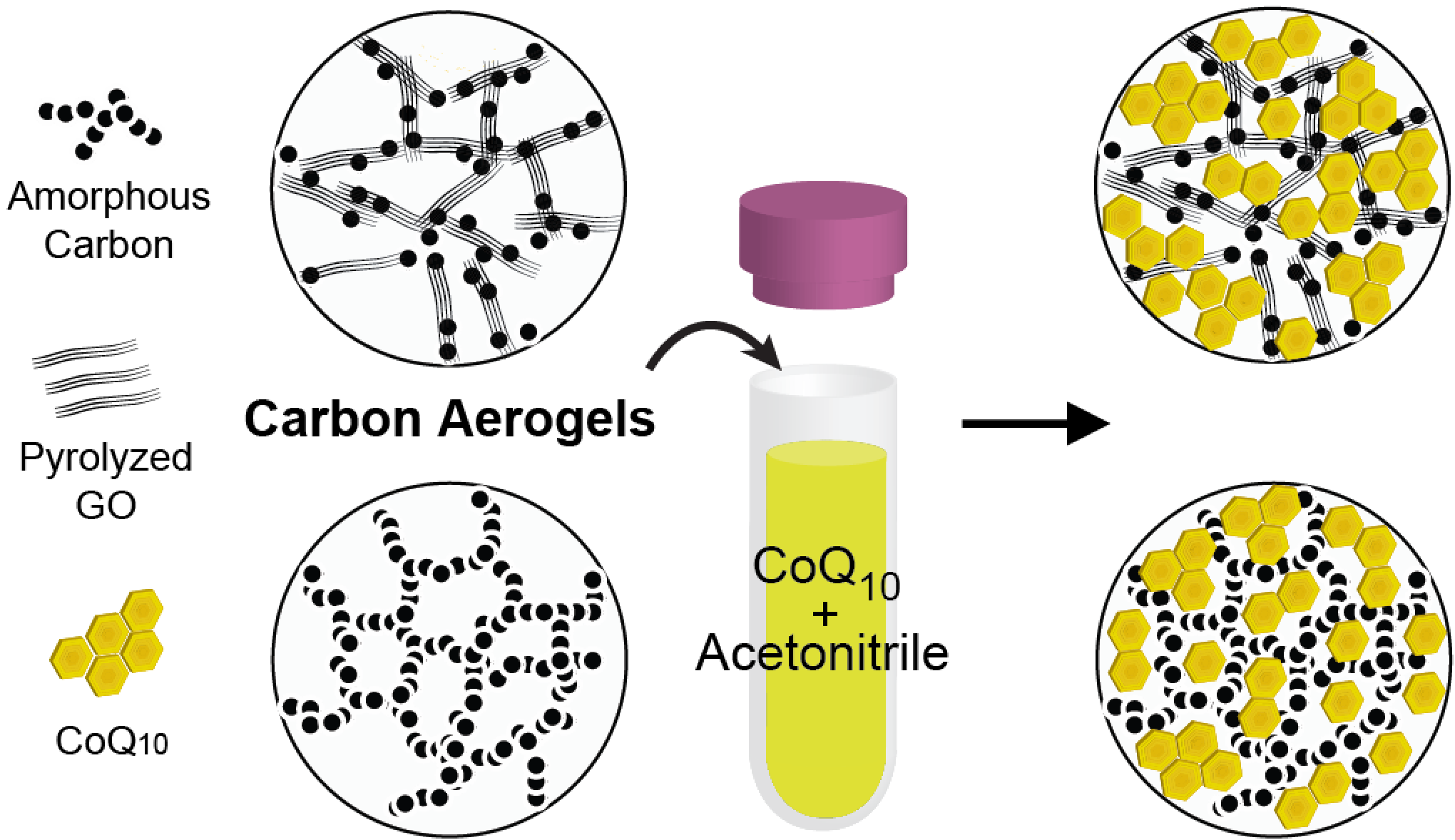
2019
62. Observation of Void Formation in Cubic NaYF4 Nanocrystals Using In Situ Heating Transmission Electron Microscopy
Bard, A., Lim, M., Zhou, X., Rodríguez Manzo, J., Alsem, D., & Pauzauskie, P. (2019). Observation of Void Formation in Cubic NaYF4 Nanocrystals Using In Situ Heating Transmission Electron Microscopy. Microscopy and Microanalysis, 25(S2), 1496-1497
61. A mail-in and user facility for X-ray absorption near-edge structure: the CEI-XANES laboratory X-ray spectrometer at the University of Washington
There are more than 100 beamlines or endstations worldwide that frequently support X-ray absorption fine-structure (XAFS) measurements, thus providing critical enabling capability for research across numerous scientific disciplines. However, the absence of a supporting tier of more readily accessible, lower-performing options has caused systemic inefficiencies, resulting in high oversubscription and the omission of many scientifically and socially valuable XAFS applications that are incompatible with the synchrotron facility access model. To this end, this work describes the design, performance and uses of the Clean Energy Institute X-ray absorption near-edge structure (CEI-XANES) laboratory spectrometer and its use as both a user-present and mail-in facility. Such new additions to the XAFS infrastructure landscape raise important questions about the most productive interactions between synchrotron radiation and laboratory-based capabilities; this can be discussed in the framework of five categories, only one of which is competitive. The categories include independent operation on independent problems, use dictated by convenience, pre-synchrotron preparatory use of laboratory capability, post-synchrotron follow-up use of laboratory capability, and parallel use of both synchrotron radiation and laboratory systems.
https://onlinelibrary.wiley.com/doi/abs/10.1107/S1600577519012839
60. Design of a Radiation-Balanced Fiber-Laser via Optically Active Composite Cladding Materials
Xiaojing Xia, Anupum Pant, E. James Davis, and Peter J. Pauzauskie, “Design of a radiation-balanced fiber laser via optically active composite cladding materials,” J. Opt. Soc. Am. B (2019).
Abstract: Although the output power of commercial fiber lasers has been reported to exceed 500 kW, the heat generated within fiber gain-media has limited the generation of higher laser powers due to thermal lensing and melting of the gain-media at high temperatures. Radiation-balanced fiber lasers promise to mitigate detrimental thermal effects within fiber gain-media based on using upconverted, anti-Stokes photoluminescence to extract heat from the optical fiber’s core. In this paper, we experimentally demonstrate that Yb(III) ions within YLiF4 (YLF) microcrystals are capable of cooling the cladding of optical fibers. We also present a design for radiation-balanced fiber lasers using a composite fiber cladding material that incorporates YLF nanocrystals as the active photonic heat engine. YLF crystals have the potential to form composite cladding materials to mitigate thermal gradients within the core and cladding based on anti-Stokes photoluminescence. Analytical models of heat transfer within the fiber are presented where the electric-field amplitude within the fiber core is responsible for both the heating of the core and the excitation of Yb(III) ions for anti-Stokes laser refrigeration in the cladding.
https://www.osapublishing.org/josab/abstract.cfm?uri=josab-36-12-3307
59. Photothermal Heating of Semiconductor Nanoribbons
Anupum Pant, E. James Davis, and Peter J. Pauzauskie. “Photothermal Heating of Semiconductor Nanoribbons” J. Phys. Chem. C (2019).
Abstract: Stokes/anti-Stokes Raman spectroscopy and heat transport analysis were used to investigate photothermal heating of cadmium sulfide (CdS) nanoribbon (NR) structures. Calculations of transient heat transfer are reported for wedged-shaped cantilevered NR and rectangular bridged NR configurations. Steady-state temperatures for both types of structures are predicted to be reached with time scales on the order of 100 microseconds. The wedge configuration analysis was used together with Raman spectroscopy measurements to estimate the imaginary refractive index of a CdSNR. The effect of interfacial heat-transfer resistance between the nanobridge and the substrate was explored to understand the time scales for heating and cooling. These experimental and computational results should apply to the design of nanoscale optoelectronic devices with applications for on-chip telecommunications, optomechanical sensing, and solid-state laser refrigeration.
https://pubs.acs.org/doi/abs/10.1021/acs.jpcc.9b05868

58. Optically Oriented Attachment of Nanoscale Metal-Semiconductor Heterostructures in Organic Solvents via Photonic Nanosoldering
Matthew J. Crane, Elena P. Pandres, E. James Davis, Vincent C. Holmberg, and Peter J. Pauzauskie. “Optically oriented attachment of nanoscale metal-semiconductor heterostructures in organic solvents via photonic nanosoldering” Nature Communications (2019).
Find a news article written about this paper here!
As devices approach the single-nanoparticle scale, the rational assembly of nanomaterial heterojunctions remains a persistent challenge. While optical traps can manipulate objects in three dimensions, to date, nanoscale materials have been trapped primarily in aqueous solvents or vacuum. Here, we demonstrate the use of optical traps to manipulate, align, and assemble metal-seeded nanowire building blocks in a range of organic solvents. Anisotropic radiation pressure generates an optical torque that orients each nanowire, and subsequent trapping of aligned nanowires enables deterministic fabrication of arbitrarily long heterostructures of periodically repeating bismuth-nanocrystal/germanium-nanowire junctions. Heat transport calculations, back-focal-plane interferometry, and optical images reveal that the bismuth nanocrystal melts during trapping, facilitating tip-to-tail “nanosoldering” of the germanium nanowires. These bismuth-semiconductor interfaces may be useful for quantum computing or thermoelectric applications. In addition, the ability to trap nanostructures in oxygen- and water-free organic media broadly expands the library of materials available for optical manipulation and single-particle spectroscopy.
https://www.nature.com/articles/s41467-019-12827-w
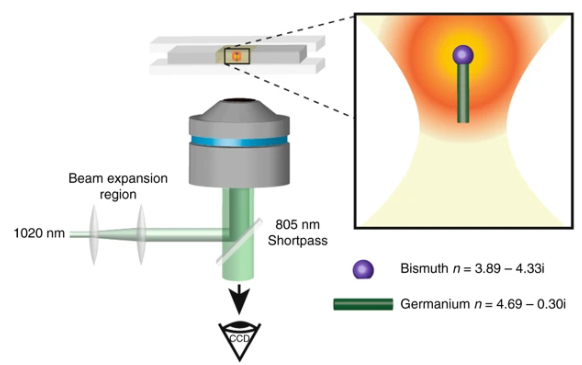
57. Can lasers really refrigerate CdS nanobelts?
Yurii V. Morozov, Shubin Zhang, Anupum Pant, Boldizsár Jankó, Seth D. Melgaard, Daniel A. Bender, Peter J. Pauzauskie and Masaru Kuno. “Can lasers really refrigerate CdS nanobelts?” Nature (2019).
Arising from: Zhang, J. et al. Nature https://www.nature.com/articles/nature11721 (2013)
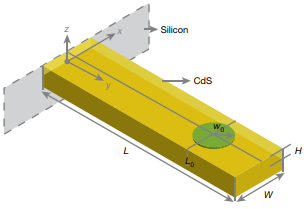
![]() PDF | Link: https://www.nature.com/articles/s41586-019-1269-1 | Status: Published
PDF | Link: https://www.nature.com/articles/s41586-019-1269-1 | Status: Published
56. Interface-Dependent Radiative Lifetimes of Yb3+, Er3+ Co-doped Single NaYF4 Upconversion Nanowires
Xuezhe Zhou, Xiaojing Xia, Bennett E. Smith, Matthew B. Lim, Alexander B. Bard, Anupum Pant, Peter J. Pauzauskie. “Interface-Dependent Radiative Lifetimes of Yb3+, Er3+ Co-doped Single NaYF4 Upconversion Nanowires” ACS Appl. Mater. Interfaces (2019).
Summary: A single-beam laser trapping instrument was used in tandem with a piezo-controlled, variable-temperature stage to precisely vary the nanowire’s distance from the substrate. The spontaneous photoluminescence lifetime of the 4S3/2 → 4I15/2 transition from Er3+ ions was observed to change by >60% depending on the ions’ separation distance from a planar (water/glass) dielectric interface. The 4S3/2 state lifetime is observed to increase by a factor of 1.62 ± 0.01 as the distance from the quartz coverslip increases from ∼0 nm to ∼40 μm.

![]() PDF | Link: https://pubs.acs.org/doi/full/10.1021/acsami.8b17271 | Status: Published
PDF | Link: https://pubs.acs.org/doi/full/10.1021/acsami.8b17271 | Status: Published
55. High-pressure, high-temperature molecular doping of nanodiamond
This publication was a special feature in an Materials Research Society bulletin!
M. J. Crane, A. Petrone, R. A. Beck, M. B. Lim, X. Zhou, X. Li, R. M. Stroud and P. J. Pauzauskie. “High-pressure, high-temperature molecular doping of nanodiamond” Science Advances (2019).
Summary: We present a versatile method to dope diamond without ion implantation by synthesis of a doped amorphous carbon precursor and transformation at high temperatures and high pressures. To explore this bottom-up method for color center generation, we rationally create silicon vacancy defects in nanodiamond and investigate them for optical pressure metrology. In addition, we show that this process can generate noble gas defects within diamond from the typically inactive argon pressure medium, which may explain the hysteresis effects observed in other high-pressure experiments and the presence of noble gases in some meteoritic nanodiamonds. Our results illustrate a general method to produce color centers in diamond and may enable the controlled generation of designer defects.
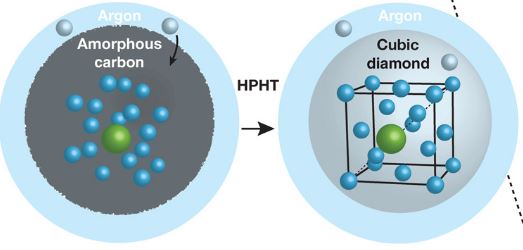
![]() PDF | Link: https://advances.sciencemag.org/content/5/5/eaau6073/tab-pdf | Status: Published
PDF | Link: https://advances.sciencemag.org/content/5/5/eaau6073/tab-pdf | Status: Published
2018
54. Electronic structures and spectroscopic signatures of silicon-vacancy containing nanodiamonds
Alessio Petrone, Ryan A. Beck, Joseph M. Kasper, Xiaosong Li, Yue Huang, Matthew Crane, Peter Pauzauskie. “Electronic Structures and Spectroscopic Signatures of Silicon-Vacancy Containing Nanodiamonds.” Physical Review B (2018).
Summary: This paper presents an important analysis of the electronic and vibrational structure of nanosized semi-conductors in the presence of mid-gap states due to localized defects, providing new insights into possible mechanisms for modulating their optical properties.
![]() PDF | Link: https://link.aps.org/doi/10.1103/PhysRevB.98.205405 | Status: Published
PDF | Link: https://link.aps.org/doi/10.1103/PhysRevB.98.205405 | Status: Published
53. Photothermal heating and cooling of nanostructures
Crane, Matthew J., Xuezhe Zhou, E. James Davis, and Peter Pauzauskie. “Photothermal heating and cooling of nanostructures.” Chemistry–An Asian Journal (2018).
Summary: This focus review outlines the analytical modeling of photothermal heat transport with an emphasis on the experimental validation of anti‐Stokes laser cooling. This general methodology can be applied to a wide range of photothermal applications, including nanomedicine, photocatalysis, and the synthesis of new materials. The review concludes with an overview of recent advances and future directions for anti‐Stokes cooling.

![]() PDF | Link: https://doi.org/10.1002/asia.201800251 | Status: Published
PDF | Link: https://doi.org/10.1002/asia.201800251 | Status: Published
52. Photothermal effects during nanodiamond synthesis from a carbon aerogel in a laser-heated diamond anvil cell
Crane, Matthew J., Bennett E. Smith, Peter B. Meisenheimer, Xuezhe Zhou, Rhonda M. Stroud, E. James Davis, and Peter J. Pauzauskie. “Photothermal effects during nanodiamond synthesis from a carbon aerogel in a laser-heated diamond anvil cell.” Diamond and Related Materials 87 (2018): 134-142.
Summary: This work measures blackbody radiation during laser-heated diamond anvil cell (LH-DAC) synthesis of nanodiamond from carbon aerogel to examine photothermal heating and its effect on diamond growth, including the phase conversion conditions and the temperature-dependence of color center formation.
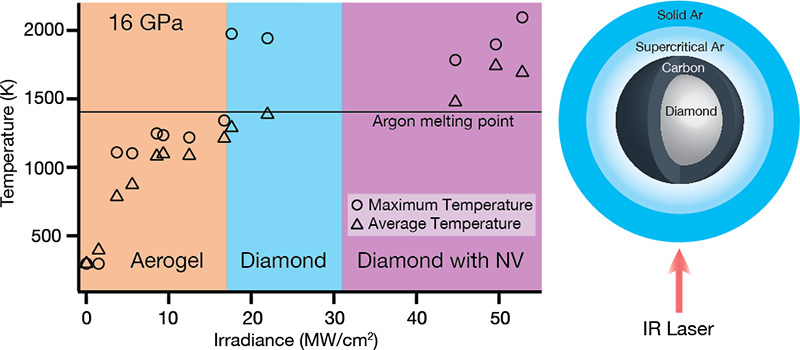
![]() PDF | Link: https://doi.org/10.1016/j.diamond.2018.05.013 | Status: Published
PDF | Link: https://doi.org/10.1016/j.diamond.2018.05.013 | Status: Published
51. Effect of Surface Passivation on Nanodiamond Crystallinity
Beck, Ryan A., Alessio Petrone, Joseph M. Kasper, Matthew J. Crane, Peter J. Pauzauskie, and Xiaosong Li. “Effect of Surface Passivation on Nanodiamond Crystallinity.” The Journal of Physical Chemistry C 122, no. 15 (2018): 8573-8580.
Summary: In this work quantum dot models with varying amounts of surface carbon passivation are prepared, optimized, and compared. The loss of the diamond sp3 lattice is examined by investigating the bond length and tetrahedral character of the carbons comprising nanodiamonds for the appearance of aromatic sp2 surface domains. Electronic transitions in the carbon K-edge region, using the energy-specific time-dependent density functional theory method, as well as vibrational spectra are computed from the optimized models.
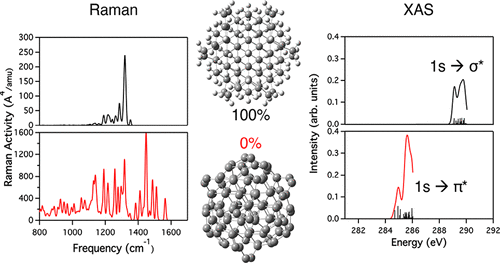
![]() PDF | Link: https://doi.org/10.1021/acs.jpcc.8b00354 | Status: Published
PDF | Link: https://doi.org/10.1021/acs.jpcc.8b00354 | Status: Published
50. Optomechanical Thermometry of Nanoribbon Cantilevers
Pant, Anupum, Bennett E. Smith, Matthew J. Crane, Xuezhe Zhou, Matthew B. Lim, Stuart A. Frazier, E. James Davis, and Peter J. Pauzauskie. “Optomechanical Thermometry of Nanoribbon Cantilevers.” The Journal of Physical Chemistry C122, no. 13 (2018): 7525-7532.
Summary: To explore the controversial claim of laser cooling of CdS, this work demonstrates a novel optomechanical experimental technique for microthermometry of a CdSNR cantilever using Young’s modulus as the primary temperature-dependent observable. Measurements of the cantilever’s fundamental acoustic eigenfrequency at low laser powers showed a red-shift in the eigenfrequency with increasing power, suggesting net heating.
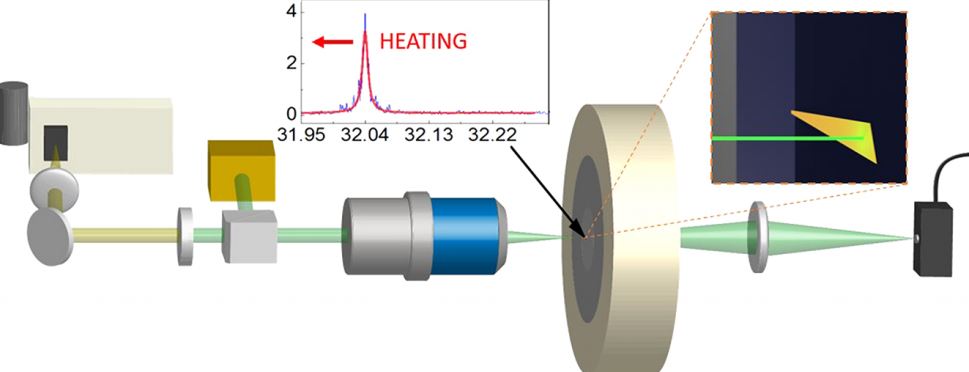
![]() PDF | Link: https://pubs.acs.org/doi/abs/10.1021/acs.jpcc.8b00365 | Status: Published
PDF | Link: https://pubs.acs.org/doi/abs/10.1021/acs.jpcc.8b00365 | Status: Published
50. Optomechanical Thermometry of Nanoribbon Cantilevers, Pant, Anupum; Smith, Bennett; Crane, Matthew; Zhou, Xuezhe; Lim, Matthew; Frazier, Stuart; Davis, E.; Pauzauskie, Peter, The Journal of Physical Chemistry C (2018).
49. Copper- and Chloride-Mediated Synthesis and Optoelectronic Trapping of Ultra-High Aspect Ratio Palladium Nanowires, Lim, M.B., Hanson, J.L., Vandsburger, L., Roder, P.B., Zhou, X., Smith, B.E., Ohuchi, F.S., Pauzauskie, P.J. Journal of Materials Chemistry A (2018) (Mar 03, 2018).
48. Patterning of Graphene Oxide with Optoelectronic Tweezers, Lim, M.B., Smith, B.E., Zhou, X., Pauzauskie, P.J., Applied Physics Letters (2018) (accepted)
2017
47. Scale-up of high specific activity 186gRe production using graphite-encased thick 186W targets and demonstration of an efficient target recycling process, Balkin, E.R., Gagnon, K., Dorman, E., Emery, R., Li, Y., Wooten, A.L., Smith, B.E., Strong, K.T., Pauzauskie, P.J., Fassbender, M.E. and Cutler, C.S., Radiochimica Acta (2017) (Aug 18, 2017).
46. Photothermal effects during nanodiamond synthesis from a carbon aerogel in a laser-heated diamond anvil cell, Crane, M.J., Smith, B.E., Meisenheimer, P.B., Zhou, X., Stroud, R.M., Davis, E.J., Pauzauskie, P.J. (2017) (in review) Link: https://arxiv.org/abs/1710.
45. Rapid synthesis of transition metal dichalcogenide–carbon aerogel composites for supercapacitor electrodes. Crane, M.J. and Lim, M.B., Zhou, X., Pauzauskie, P.J. Natutre Microsystems and Nanoengineering (2017) (Jul 17, 2017).
44. Laser refrigeration of rare-earth doped sodium-yttrium-fluoride nanowires. Zhou, X., Roder, P.B., Smith, B.E., Pauzauskie, P.J. Proc. SPIE 10121, Optical and Electronic Cooling of Solids II, 1012103 (Feb 17, 2017).
43. Chitosan-Gated Magnetic-Responsive Nanocarrier for Dual-Modal Optical Imaging, Switchable Drug Release, and Synergistic Therapy. Wang, H., Mu, X., Revia, R., Wang, K., Zhou, X., Pauzauskie, P.J., Zhou, S., Zhang, M. Advanced Healthcare Materials (2017) 1601080.
42. Photothermal heating of nanoribbons, Smith, B.E., Zhou, X., Davis, E.J., Pauzauskie, P.J. Optical Engineering (2017) 56:011111.
2016
41. Pulsed Photothermal Heating of One-Dimensional Nanostructures. Roder, P.B., Manandhar, S., Devaraj, A., Perea, D.E., Davis, E.J., Pauzauskie, P.J. J. Phys. Chem. C (2016) 120:21730-21739.
40. Deuteron irradiation of W and WO3 for production of high specific activity 186Re: Challenges associated with thick target preparation. Balkin, E.R., Gagnon, K., Dorman, E.F., Emery, R., Smith, B.E., Pauzauskie, P.J., Fassbender, M.E., Cutler, C.S., Ketring, A.R., Jurisson, S., Wilbur, D.S. Appl. Radiat. Isot. (2016) 115:197-207.
39. Laser refrigeration of ytterbium-doped sodium-yttrium-fluoride nanocrystals, Zhou, X., Smith, B.E., Roder, P.B., Pauzauskie, P.J. Adv. Mater. (2016)
38. Accelerator-Based Production of the 99mTc-186Re Diagnostic-Therapeutic Pair using Metal Disulfide Targets (MoS2, WS2, OsS2). Gott M.D., Hayes C.R., Wycoff, D.E., Balkin E.R., Smith B.E., Pauzauskie P.J., Fassbender, M.E., Cutler, C.S., Ketring, A.R., Wilbur, D.S., Jurisson, S. (2016) Appl. Radiat. Isot. 114:159-166
37. Recovery of Si-IV nanowires from extreme GPa pressure, Smith, B.E., Zhou, X., Roder, P.B., Abramson, E.H., Pauzauskie, P.J. (2016) J. Appl. Phys. 119(18):185902
2015
36. Laser refrigeration of optically-trapped hydrothermal nanocrystals in physiological media, Roder*, P.B., Smith*, B.E., Zhou*, X., Crane, M.J., Pauzauskie, P.J. (2015) PNAS, 112(49):15024-15029
35. Hot Brownian thermometry and cavity-enhanced harmonic generation with nonlinear optical nanowires. Smith*, B.E., Roder*, P.B., Zhou, X., Pauzauskie, P.J. (2015) Chem. Phys. Lett. 639:310-314. (invited feature article), (cover highlight)
34. Ultrafast sol-gel synthesis of graphene aerogel materials. Lim, M.B., Hu, M., Manandhar, S., Sakshaug, A., Strong, A., Riley, L., Pauzauskie, P.J.; (2015) Carbon 95:616-624.
33. Photothermal superheating of water with ion-implanted silicon nanowires. Roder, P.B., Manandhar, S., Smith, B.E., Zhou, X., Shutthanandan, V., Pauzauskie, P.J. (2015) Adv. Opt. Mater. 3(10):1362-1367.
32. Singlet-oxygen generation from individual semiconducting and metallic nanostructures during near-infrared laser trapping. Smith, B.E., Roder, P.B., Hanson, J.L., Manandhar, S., Devaraj, A., Perea, D.E., Kim, W.J., Kilcoyne, A.L.D., Pauzauskie, P.J. (2015) ACS Photonics 2:559-564.
31. Nanoscale materials for hyperthermal theranostics. Smith, B.E., Roder, P.B., Zhou, X.Z., Pauzauskie, P.J. (2015) Nanoscale 7:7115-7126. (invited review article)
30. Mass transport in nanowire synthesis: an overview of scalable nanomanufacturing. Crane, M.J., Pauzauskie, P.J., (2015) J. Mater. Sci. Technol. 31:523-532. (invited review)
2014
29. Rapid sol-gel synthesis of nanodiamond aerogel. Manandhar, S., Roder, P.B., Hanson, J.L., Lim, M.B., Smith, B.E., Mann, A., Pauzauskie, P.J., (2014) J. Mater. Res. 29:2905-2911. (invited feature article)
28. Photothermal Heating of Nanowires. Roder, P.B., Smith, B.E., Davis, E.J., Pauzauskie, P.J. (2014) J. Phys. Chem. C, 118:1407-1416.
2012
27. Nanowire heating by optical electromagnetic irradiation. Roder, P.B., Pauzauskie, P.J., Davis, E.J. (2012) Langmuir 28:16177-16185.
Before UW
26. Mechanically robust 3D graphene macroassembly with high surface area. Worsley, M.A., Kucheyev, S.O., Mason, H.E., Merrill, M.D., Mayer, B.P., Lewicki, J, Valdez, C.A., Suss, M.E., Stadermann, M., Pauzauskie, P.J., Satcher, J. H., Biener, J., Baumann, T.F. (2012), Chem. Commun. 48:8428-8430.
25. In situ Raman Spectroscopy of COOH-Functionalized SWCNTs Trapped with Optoelectronic Tweezers. Pauzauskie, P.J., Jamshidi, A., Zaug, J.M., Baker, S., Han, T.Y-J., Satcher, Jr., J.H., Wu, M.C.. (2012), Adv. Optoelectron. 2012:869829.
24. High surface area sp2-cross-linked three-dimensional graphene monoliths. Worsley, M.A., Olson, T.Y., Lee, J.R.I., Willey, T.M., Nielsen, M.H., Roberts, S.K., Pauzauskie, P.J., Biener, J, Satcher, J.H., Baumann, T.F.. (2011), J. Phys. Chem. Lett. 2:921-925.
23. Synthesis and characterization of a nanocrystalline diamond aerogel. Pauzauskie#, P.J., Crowhurst, J.C., Worsley, M.A., Laurence, T.A., Kilcoyne, A.L.D., Wang, Y., Willey, T., Visbeck, K., Fakra, S., Evans, W.J., Zaug, J.M., Satcher, Jr., J.H.. (2011) , PNAS 108:8550-3 [Featured in Nature, MSNBC, Royal Society of Chemistry, Nature Chemistry, Discovery News]
22. Synthesis of Graphene Aerogel with High Electrical Conductivity. Worsley, M.A., P.J. Pauzauskie, T.Y. Olson, J. Biener, J.H. Satcher, and T.F. Baumann. (2010) J. Am. Chem. Soc. 132:14067-14069.
21. Parallel trapping of multiwalled carbon nanotubes with optoelectronic tweezers.Pauzauskie*, P.J., Jamshidi*, A., J.K. Valley, J.H. Satcher, and M.C. Wu. (2009) Appl. Phys. Lett. 95:113104-3.
20. Imaging of single GaN nanowires by tip-enhanced Raman spectroscopy. Marquestaut, N., D. Talaga, L. Servant, P. Yang, P. Pauzauskie, and F. Lagugne-Labarthet. (2009) J. Raman Spectrosc. 40:1441-1445.
19. Properties of single-walled carbon nanotube-based aerogels as a function of nanotube loading. Worsley, M.A., P.J. Pauzauskie, S.O. Kucheyev, J.M. Zaug, A.V. Hamza, J.H. Satcher, and T.F. Baumann. (2009) Acta Mater. 57:5131-5136.
18. High surface area carbon nanotube-supported titanium carbonitride aerogels. Worsley, M.A., J.D. Kuntz, P.J. , O. Cervantes, J.M. Zaug, A.E. Gash, J.H. Satcher, and T.F. Baumann. (2009) J. Mater. Chem. 19:5503-5506.
17. NanoPen: Dynamic, Low-Power, and Light-Actuated Patterning of Nanoparticles. Jamshidi, A., S.L. Neale, K. Yu, P.J. Pauzauskie, P.J. Schuck, J.K. Valley, H.Y. Hsu, A.T. Ohta, and M.C. Wu. (2009) Nano Lett. 9:2921-2925.
16. X-ray diffraction of electrodeposited nanocrystalline nickel under high pressure. Grant, C.D., J.C. Crowhurst, T. Arsenlis, E.M. Bringa, Y.M. Wang, J.A. Hawreliak, P.J. Pauzauskie, and S.M. Clark. (2009) J. Appl. Phys. 105:084311.
15. Direct photonic-plasmonic coupling and routing in single nanowires. Yan, R., P. Pauzauskie, J. Huang, and P. Yang. (2009) PNAS 106:21045-21050.
14. Dynamic manipulation and separation of individual semiconducting and metallic nanowires. Jamshidi*, A., P.J. Pauzauskie*, P.J. Schuck, A.T. Ohta, P.Y. Chiou, J. Chou, P.D. Yang, and M.C. Wu. (2008) Nature Photon. 2:85-89. (cover highlight)
13. Tunable nanowire nonlinear optical probe. Nakayama*, Y., P.J. Pauzauskie*, A. Radenovic*, R.M. Onorato*, R.J. Saykally, J. Liphardt, and P.D. Yang. (2007) Nature 447:1098 (cover highlight, featured in Nature Methods)
12. Transition-metal doped zinc oxide nanowires. Yuhas, B.D., D.O. Zitoun, P.J. Pauzauskie, R.R. He, and P.D. Yang. (2006) Angew. Chem. Int. Ed. 45:420-423.
11. Optical trapping and integration of semiconductor nanowire assemblies in water. Pauzauskie, P.J., A. Radenovic, E. Trepagnier, H. Shroff, P.D. Yang, and J. Liphardt. (2006) Nat. Mater. 5:97-101.
10. Electrostatics of nanowire transistors with triangular cross sections. Vashaee, D., A. Shakouri, J. Goldberger, T. Kuykendall, P. Pauzauskie, and P.D. Yang. (2006) J. Appl. Phys. 99: 054310.
9. Nanowire photonics. Pauzauskie, P.J., and P. Yang. (2006) Mater. Today 9:36-45.
8. Semiconductor nanowire ring resonator laser. Pauzauskie, P.J., D.J. Sirbuly, and P.D. Yang. (2006) Phys. Rev. Lett. 96: 143903.
7. Optical routing and sensing with nanowire assemblies. Sirbuly, D.J., M. Law, P. Pauzauskie, H.Q. Yan, A.V. Maslov, K. Knutsen, C.Z. Ning, R.J. Saykally, and P.D. Yang. (2005) PNAS 102:7800-7805.
6. Polarized Raman confocal microscopy of single gallium nitride nanowires. Pauzauskie, P.J., D. Talaga, K. Seo, P.D. Yang, and F. Lagugne-Labarthet. (2005) J. Am. Chem. Soc. 127:17146-17147.
5. Gallium nitride nanowires with a metal initiated metal-organic chemical vapor deposition (MOCVD) approach. Lee, S.K., H.J. Choi, P. Pauzauskie, P.D. Yang, N.K. Cho, H.D. Park, E.K. Suh, K.Y. Lim, and H.J. Lee. (2004) Phys. Status Solidi B 241:2775-2778.
4. Crystallographic alignment of high-density gallium nitride nanowire arrays. Kuykendall*, T., P.J. Pauzauskie*, Y.F. Zhang, J. Goldberger, D. Sirbuly, J. Denlinger, and P.D. Yang. (2004) Nat. Mater. 3:524-528. (cover highlight)
3. Watching GaN nanowires grow. Stach, E.A., P.J. Pauzauskie, T. Kuykendall, J. Goldberger, R.R. He, and P.D. Yang. (2003) Nano Lett. 3:867-869.
2. Metalorganic chemical vapor deposition route to GaN nanowires with triangular cross sections. Kuykendall, T., P. Pauzauskie, S.K. Lee, Y.F. Zhang, J. Goldberger, and P.D. Yang. (2003) Nano Lett. 3:1063-1066.
1. Self-organized GaN quantum wire UV lasers. Choi, H.J., J.C. Johnson, R.R. He, S.K. Lee, F. Kim, P. Pauzauskie, J. Goldberger, R.J. Saykally, and P.D. Yang. (2003) J. Phys. Chem. B 107:8721-8725. (cover highlight)
* – equal contribution
# – corresponding author

